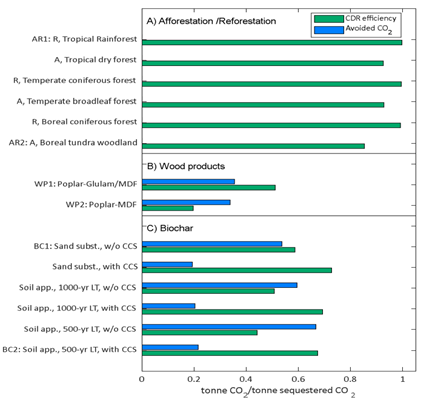As part of its effort to investigate the feasibility and sustainability of negative emission technologies and practices (NETPs), NEGEM partners carried out an assessment of three land-based NETPs – afforestation and reforestation (A/R), soil carbon sequestration (SCS) with biochar, and building with wood materials – against a set of 16 environmental, technical, health-related and social KPIs. More specifically, the assessment considered: six A/R scenarios (employing a different tree species for afforestation or reforestation in a tropical, temperate, or boreal climate); six scenarios on the use of biochar (with and without carbon capture and storage) produced from poplar (Populus euphratica) as sand replacement in building materials and as soil improvement assuming two different degradation rates; and using two poplar wood products as building materials, either glulam or medium density fireboard (MDF).
Afforestation and reforestation were found to be the best in terms of carbon dioxide removal (CDR) efficiency and environmental and socioeconomic performance across all of the scenarios considered. Between the two other NETPs, SCS via biochar and building with wood materials, the former markedly outperformed the latter in most of the KPIs, especially when the use of biochar is coupled with carbon capture and storage.

The analysis shows that while A/R is very promising with regards to carbon sequestration, it has substantial impacts in terms of land use, which varies depending on the climatic areas and their corresponding capacity to store carbon in the soil and in biomass.
This land use can have negative consequences for local biodiversity, but at the same time an increased coverage of tree in an area can have beneficial effects for human health and prevent externalities. When biochar is used as a soil amendment a portion of its carbon content can be released by reacting with atmospheric oxygen, but this loss could be reduced by using biochar as a sand substitute in building materials. However, the main hurdle to a wide implementation of biochar is the high cost of the pyrolysis process needed to produce it when compared to A/R or building with wood. Building with wood had the worst performance out of the three NETPs considered, mainly because of the production process of MDF.
Land-based NETPs present a variety of risks and downsides such as their susceptibility to weather events like fires or droughts, thus a diverse portfolio of (land-based and non land-based) NETPs is the best approach to build a sound carbon removal strategy.
This post is based on a report by Selene Cobo, Gonzalo Guillén-Gosálbez (ETH Eidgenössische Technische Hochschule Zürich); Ariane Albers, Lorie Hamelin (INSA Institut National des Sciences Appliquées Toulouse); Constanze Werner (Potsdam Institute for Climate Impact Research); Nixon Sunny (Imperial College London).


